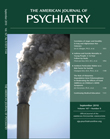Response to Khandaker et al. Letter
To the Editor: Dr. Khandaker et al. mention that the development of manic symptoms in the patient, which occurred after oseltamivir use, may have been a red herring in the causation. This would be difficult to conclude, since she experienced only mild upper respiratory symptoms and fever for 1 day and the fever subsided before the start of oseltamivir and onset of manic symptoms. However, she and her parents could note that there was a marked change in her personality, with elated mood, after taking oseltamivir. A previous case series showed that neuropsychiatric adverse events after oseltamivir use may start on the first day of treatment (1). The close temporal relationship between the onset of manic symptoms and the use of oseltamivir in our patient, with relatively mild upper respiratory symptoms and fever that subsided before the onset of mania, suggests that oseltamivir-induced mania was a more likely diagnosis.
Regarding the genetic difference, it has been suggested that a nonsynonymous single nucleotide polymorphism in human cytosolic sialidase is more prevalent in Asian populations. This polymorphism affects the activity of sialidase, which may cause neuropsychiatric adverse events in patients receiving oseltamivir (2). This may account for the observation that the majority of cases were reported in Japan.
Both oseltamivir and influenza have been reported to be associated with the development of neuropsychiatric events (3–5). Moreover, fatal neuropsychiatric adverse reactions after oseltamivir use have been reported (1). The aim of our case report was to encourage vigilant monitoring of the mental state of patients after using oseltamivir until we have a better understanding about the properties of this drug.
1. : Fatal neuropsychiatric adverse reactions to oseltamivir: Case series and overview of causal relationships. Int J Risk Safety Med 2008; 20:5–36Google Scholar
2. : A nonsynonymous SNP in human cytosolic sialidase in a small Asian population results in reduced enzyme activity: potential link with severe adverse reactions to oseltamivir. Cell Res 2007; 17:357–362Crossref, Medline, Google Scholar
3. Roche Laboratories: Tamiflu prescribing information. http://www.gene.com/gene/products/information/tamiflu/pdf/pi.pdfGoogle Scholar
4. : Clinical characteristics of children with abnormal behaviors associated with influenza infection. J Jpn Pediatr Soc 2007; 111:38–44Google Scholar
5. : Oseltamivir and neuropsychiatric behaviors in children: case report. J Paediatr Sci 2009; 1:e6Google Scholar



